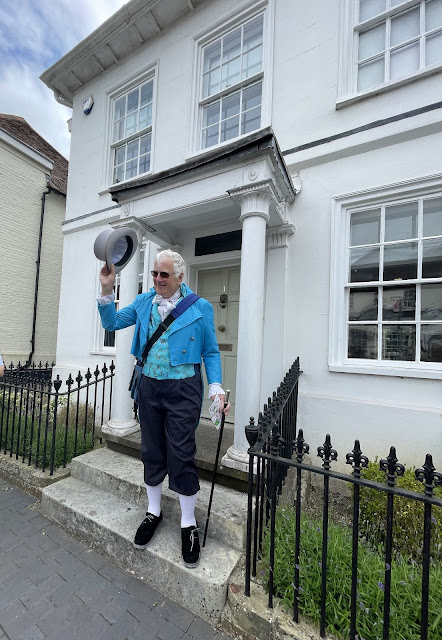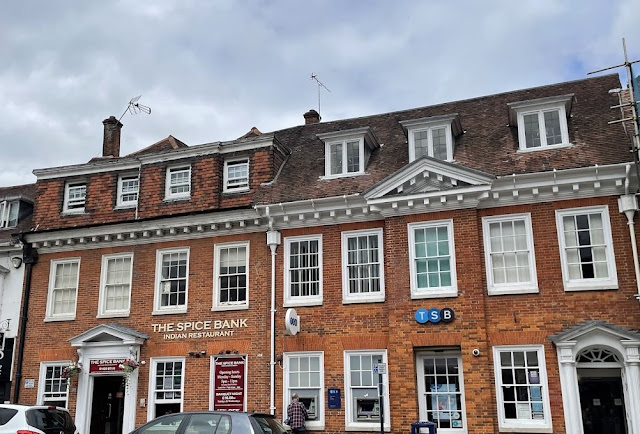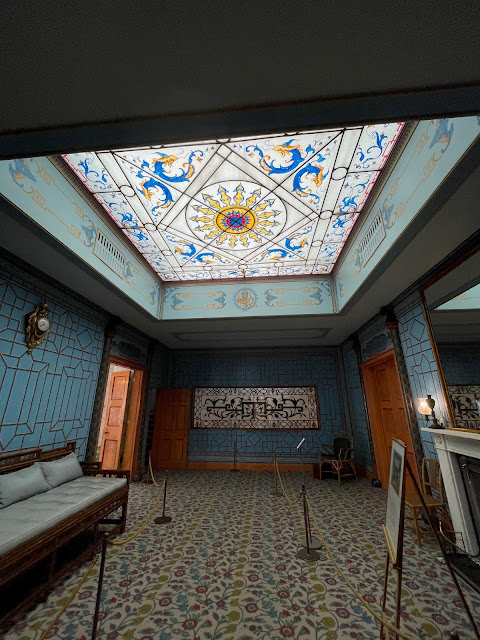It is Regency Week again and time to return to Alton for Regency Day. You may have read my previous, independent tour of Alton, and this time I decided to take a guided walk as part of the programme. I will take you on this guided tour today!
Alton is a small market town within walking distance from Chawton where Jane Austen spent the last years of her life. Jane would often walk to Alton to meet friends, shop, pick up post or board a carriage to London.
We met our entertaining and knowledgeable guide, Bob Bookers, who started the tour from 1 Normandy Street - Hill House - the home of William Parker Terry. Jane would often dine with the Terry family of Dummer, close friends of the Austens.
We then crossed the road and saw William Curtis' house at 4 High Street (above). William Curtis was a surgeon apothecary, whom Jane Austen affectionately called "the Alton Apothy". He tried to cure Jane Austen during her final illness, but sadly he was unable to find a cure, and Jane Austen travelled to Winchester in search of a better treatment where she later passed away. I wrote more about William Curtis in this blog.
6 High Street, was the home of James Battin Coulthard. In 1813, Jane wrote, "The Coultharts were talked of you may be sure; no end of them; Miss Terry had heard that they were going to rent Mr Bramston's House at Oakley."
Number 10 (above) housed the bank of Austen, Grey and Vincent from 1806-1812, the Austen being Jane's brother, Henry. Henry started off his career in the army and then moved onto banking, which ended disastrously in bankrupcy, leading on to a further career change into the clergy. Henry's bankrupcy was a huge financial blow to the Austen family.
Number 40 (left) was occupied by Richard Marshall, who sublet his farmhouse to the Lefroy family. You may be aware of the Irishman Tom Lefroy, with whom Jane Austen had a brief flirtation at the age of twenty.
Number 42 (right) was the home of Thomas Clement, an attorney who married the niece of the naturalist Gilbert White. Thomas' son married Jane's neighbour, Ann Mary Prowting in 1811, and in 1813 Jane wrote: " I went with (Mrs Clement) and her Husband in their Tax-cart; - civility on both sides; I would rather have walked, & no doubt, they must have wished I had". A typical example of Jane's rather sarcastic humour!
The Swan Hotel occupies number 29. This is where Jane would board a stagecoach - Collyer's Coach - for London and Southampton. In Southampton, I recently noticed a sign saying that it would take 10 hours to reach Alton by stagecoach. Our tour guide informed us that the journey to London would have taken 6 hours. In 1814, Jane wrote to Cassandra, "I must provide for the possibility, by troubling you (to) send up my Silk Pelisse by Collyer on Saturday." This very pelisse (overcoat) is now on display at the Jane Austen House Museum.
The oldest house in Alton is situated at 8 and 10 Turk Street. There are guided tours into the house every third weekend of each month.
Lansdowne House at 74 High Street (covered by market canopies on Regency Day) was the home of apothecary and surgeon John Newnham. Jane does not seem to have been impressed by this doctor, as she wrote a mocking poem about her visit to his house in 1811. This is one of the most beautiful buildings here, with gorgeous architectural detail at the top of the building.
Many of these buildings were known to Jane Austen.
This building above is the oldest commercial establishment in Alton, dating back to the 1500s.
The town hall dates back to 1813, and Jane would have been familiar with it.
We then walked on, and came to this house where the poet Edmund Spencer, who wrote "Fairy Queen", lived in the 16th Century.
The River Wey runs through Alton, and this is where watercress was grown - so famous in this area and rare elsewhere.
The Church of St Lawrence is medieval, dating back to 1070.
The Terry family - good friends of the Austens, as mentioned earlier - have a vault and a memorial plaque here. Interestingly, I walked past this memorial plaque to someone with the surname of "Steele"! Jane may well have been inspired by this name at some point in time, although she wrote the initial drafts of Sense and Sensibility in Steventon.
Lastly, we walked past Gill's Almshouses, which provided housing for the poor. The famous magistrate and captain in Cromwell's army, Thomas Gill, built these houses. The almshouses consist of eight flats, and housing is still offered to those living in Alton who cannot afford a home.
If you would like to read more, please refer to local historian, Jane Hurst's, excellent guidebook.
For references and further reading: Jane Hurst: Jane Austen and Alton.




























.jpg)




































